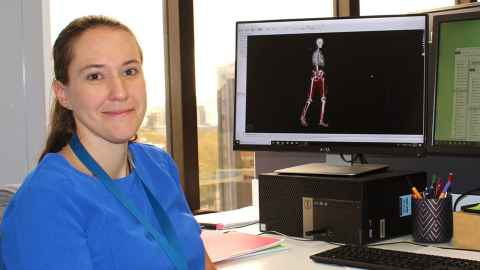Protecting the bones of children with cerebral palsy
12 August 2022
A new research project led by Dr Julie Choisne aims to prevent bone deformation in children with cerebral palsy, and the hip, knee and ankle abnormalities that can result from the condition.

Dr Choisne has just received a $250,000 Health Research Council Emerging Researcher grant to help her do so.
Cerebral palsy is the leading cause of childhood physical disability, affecting 17 million children worldwide and 12,000 in New Zealand.
The condition is caused by damage to the parts of the brain that control movement, balance, and posture.
People with the condition typically walk in a way that compensates for their abnormal muscle activity.
“They walk in a way that is most efficient for them, but not good for their bones,” says Dr Choisne. “The mechanical load on the foot, for example, is different from what it should be, which deforms the bones’ alignment in the ankle.”
There is no cure for cerebral palsy, but there are interventions that can have a huge impact on the development of a child’s musculoskeletal system if they are assessed and treated early enough.
“But left untreated, their bones will deform as they grow, it will become too painful for them to walk, and they may end up in a wheelchair,” says Dr Choisne.
In New Zealand children with cerebral palsy are only assessed from the age of six, by which age their bones have already been affected by an abnormal gait.
Even then, expert assessment is expensive, limited and for many, inaccessible; there is only one gait clinic in New Zealand that specialises in the assessment of children with cerebral palsy.
This may be why cerebral palsy-related conditions, such as hip and knee deformities are unusually high in New Zealand and even higher among Maori and Pacific Island populations.
In the first part of her project, Dr Choisne will draw on the CT scans of 200 children aged four to 18 years old, sourced through the Victorian Institute of Forensic Medicine.
She will use this data to build a paediatric population-based atlas of the normal development of the tibia, femur and pelvis bones of four to 18-year-olds, which she will use to build a computational model of both normal and abnormal development.
This atlas will allow for personalised medicine to the patient instead of a one-model-fits all which will let us understand the relationship between the form and function of the bones in children.
By combining that model with wearable sensors developed at the ABI, this will allow for a quick and inexpensive assessment of a child’s gait, its potential impact on their musculoskeletal system, and what interventions may help.
“So that will allow us to identify where a problem is located and what needs to be adjusted or targeted through treatment,” says Dr Choisne.
The point is to be able to assess the child as early as possible, teach them and help them walk better as early as possible, and protect them from the consequences of walking differently, she says.
“Our joints and cartilage are not made for abnormal walking, so if you can teach a child how to walk better as early as possible, they might not even need an assistive device to walk when they get older, and most of them won’t end up in a wheelchair.”
Currently assessment of the movement of a child with cerebral palsy is complicated, expensive and for many, inaccessible, but Dr Choisne is confident she will ultimately be able to develop an assessment tool that would be easy to use, in any hospital or clinic in the country.
“It would be easily implemented in the clinic, and inform orthopedic decisions faster, and more accurately than before, and children and families wouldn’t have to travel the vast distances that many do now.”
Margo White I Media adviser
DDI 09 923 5504
Mob 021 926 408
Email margo.white@auckland.ac.nz
Want to help us make a difference?
There are many ways you can make a difference and support the Auckland Bioengineering Institute - you can make a donation or bequest, or even subscribe to our newsletter.